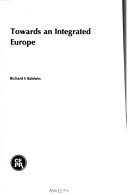Powerful political and economic forces are driving a rapid integration of post-communist Europe, yet short-term political considerations have produced piecemeal trade arrangements instead of a coherent structure. Individual agreements have been signed linking the European Union to several Central and East European countries (CEECs), EFTA to several CEECs, a few CEECs to each other and EU to EFTA. Although the agreements have many similar features, most have been negotiated separately; their coverage differs significantly; and there are no links among them. Is this maze of bilateral deals the best configuration for promoting pan-European growth and stability? How will these agreements and their interactions influence growth, trade, investment, migration and income disparities in Europe? Richard Baldwin has marshalled the best available empirical evidence and analytic techniques to establish a framework for organizing our thinking on why the structure and pattern of trade arrangements matters. On this basis, he assesses the alternative paths towards European economic and political integration. The economic analysis is objective, but political economy on this scale is likely to lead to strong policy conclusions, as indeed it does here. Aspects of his own proposal will be controversial, but it offers a deeply considered basis for further discussion and ultimately for action. All will benefit from Baldwin's insights and the challenge he puts forward for a more positive and consistent approach to the architecture of Europe.
- ISBN10 1898128138
- ISBN13 9781898128137
- Publish Date 15 April 1994
- Publish Status Active
- Publish Country GB
- Imprint Centre for Economic Policy Research
- Format Paperback
- Pages 256
- Language English
